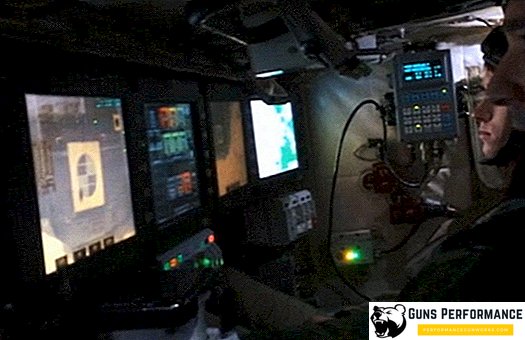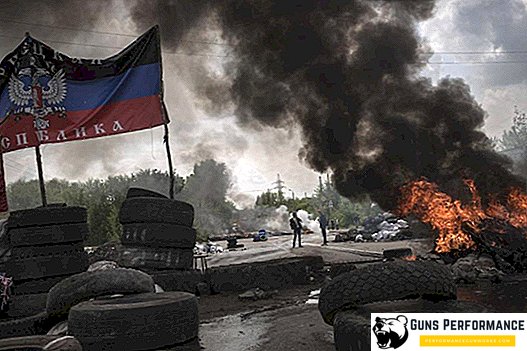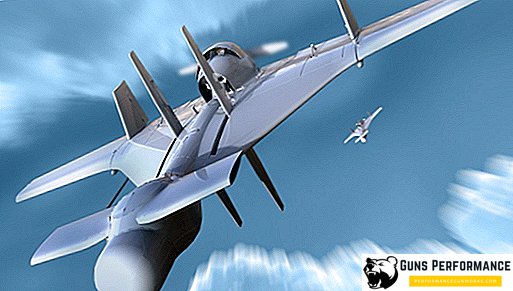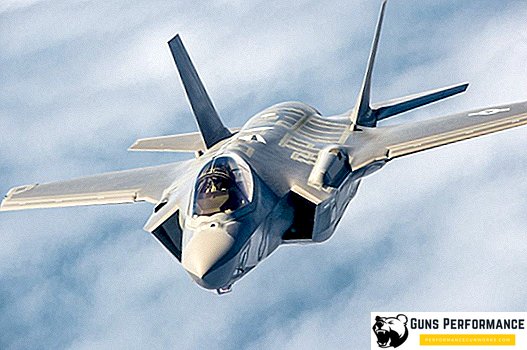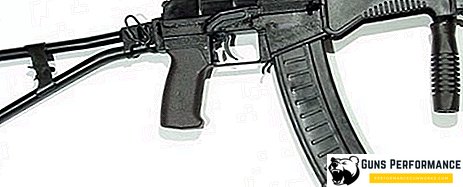The second half of the last century was a time of rapid development of combat aircraft. Aircraft became faster, got new types of weapons and aiming systems. Attack helicopters appeared, at first they were clumsy and slow machines, suitable only for transporting cargo and wounded soldiers, but very quickly became formidable strike machines. As a result, it was the threat of an air attack that became the most dangerous for the modern ground forces.
The history of several local conflicts of the end of the past and the beginning of this century showed that aviation is capable of deciding the fate of an armed conflict. The emergence of high-precision air-to-ground missiles, new fire control systems, the rapid development of unmanned aerial vehicles only strengthen the role of aviation. According to most military experts, in this century it is aviation that will become the queen of the battlefield.

And what about the ground forces? What can they do to counter the threat from the air? How can they protect themselves? In recent decades, many leading states have been actively developing short- and medium-range anti-aircraft missile systems designed to protect troops and infrastructure.
These air defense systems make it possible to most effectively fight against maneuverable and low-flying air targets, including front-line aviation (including attack helicopters) and cruise missiles.
In 1990, Russia began to develop a new anti-aircraft missile-cannon complex (ZRPK) of short-range "Pantsir-S1", it was created to protect parts of the ground forces and the most important industrial facilities.

The history of the creation of ZRPK "Pantsir-C1"
In the mid-60s, the legendary Soviet anti-aircraft installation ZSU-23-4 Shilka was created. However, in the mid 70s it became clear that this complex was already morally obsolete. The 23mm cannon could not effectively hit high-speed and well-protected aerial targets. Radar equipment also did not meet the requirements of the time.
At the end of the 70s, the development of a fundamentally new anti-aircraft complex began, which was supposed to cover ground forces. The new air defense system received a more powerful 30-mm cannon and a missile system to more effectively combat enemy helicopters. In 1982, the new ZRPK "Tunguska" was adopted.
The development of the Tunguska air defense system was carried out by the Tula Instrument Engineering Bureau. The 30-mm cannon of this ZRPK can fire low-flying targets. However, its rocket armament "Tunguska" could only be used during stops and in conditions of visual contact with an air target.
According to its characteristics, the Tunguska air defense missile system was undoubtedly a new step in the protection of ground forces against enemy aircraft. In the mid-1980s, military aviation itself began to change rapidly. Cruise missiles, unmanned aerial vehicles operating at low and ultra-low altitudes appeared, and new high-precision weapons and electronic warfare devices (EW) were actively developed.
An analysis of previous conflicts has clearly shown that aviation tactics will be based on the use of precision weapons, which should completely suppress the enemy’s air defenses. To counter such tactics, it was necessary to teach the air defense system to effectively counter high-precision weapons.

It is obvious that the air defense missile system "Tunguska" could no longer effectively carry out its functions, and in 1990, the development of a new air defense system, capable of responding to the challenges of time, began. The creation of a new complex was entrusted to the Tula Instrument Design Bureau. The following tasks were set before the new ZRPK: protection of mobile units of the ground forces, important military and economic facilities. In addition, the air defense system was supposed to protect air defense systems with a long range of destruction (for example, C-300).
A new anti-aircraft missile and gun complex called "Pantsir-S1". In 1994, the first prototype of this machine was ready.
At first, the military did not show much interest in the new anti-aircraft complex. "Pantsir-S1" did not know how to shoot in motion, and in the opinion of the military, could not successfully fight with precision weapons at a distance of more than 12 kilometers. The army did not suit its characteristics. Given the difficult economic situation of the early 90s, the car was forgotten for a while.
But here the case intervened in the fate of the car. The Russian air defense system was very interested in the UAE’s military, but they required qualitatively different characteristics, and the Tula designers had to radically alter the complex. The car was installed new gun armament, more advanced anti-aircraft missiles that could hit targets at a distance of twenty kilometers, radar and fire control system (FCS) have changed significantly. It can be said that the Pantsir-S1 experienced a rebirth, becoming a much more perfect and formidable machine. Tests of the new version took place in 2006.
The amount of the export contract was 734 million dollars. But due to the fault of the contractors, the contract terms were broken, and the first complexes were delivered to the UAE only in 2009.
Then there was a contract with Algeria in the amount of $ 500 million. For this country 38 complexes were made. "Pantsir-S1" also purchased Syria, Oman, Brazil, Iran and Iraq. This complex was officially adopted in 2012 by the Russian army. They plan to replace all the air defense system "Tunguska". In 2018, a modification of the complex, the Pantsir-C2, should appear, and a year later a new version that can fight with ballistic missiles. In 2018, the appearance of a ship modification of the complex is expected; its exact characteristics are still unknown.

According to unverified information, the cost of a single complex of the Pantsir-C1 complex consists of $ 13.15 to $ 14.67 million.
Until the end of 2014, 36 anti-aircraft missile systems of this type were delivered to the Russian army.
Opportunities "Carapace-C1"
ZTRK "Pantsir-S1" - is a universal means of dealing with air targets, having a speed of up to 1000 m / s, at a distance of 200 to 20 thousand meters. The complex can destroy air targets at a height of from 5 to 15 thousand meters. He can also fight with enemy light armored vehicles and his living strength. This complex can almost instantly detect and destroy an airplane, a helicopter, a cruise missile, or a controlled enemy bomb.
"Pantsir-S1" can be placed on a wheeled or tracked chassis, stationary installation is also possible. The complex has a communication system protected from interference.
Destruction of air targets is carried out with the help of cannon armament and anti-aircraft missiles with infrared and radar homing systems.
Each vehicle has three locators: early warning radar and target designation radar, tracking and guidance radar, as well as passive optical radar.
The target detection radar can simultaneously conduct up to twenty objects, transmit their coordinates and speed data to the on-board computer. In addition, this radar determines the type of target and its nationality.

The radar tracking of targets and missiles largely determines the high efficiency of the complex. It is equipped with a phased antenna array. The radar allows ZPRK to fire at once at three targets, while at the most dangerous of them a salvo of two missiles is possible.
The Optical Electronic System (ECO) is used for shooting low-flying targets as well as ground targets.
"Pantsir-S1" can conduct aimed shooting while moving, which is beyond the power of foreign analogues of this complex. This allows the machine to more effectively cover the columns of equipment from air strikes.
The armament of the complex consists of two twin 30-mm 2A38M anti-aircraft machine guns with a firing range of four kilometers and 12 57E6 anti-aircraft missiles (SAM) located in two blocks on each side of the combat module.
Rocket 57E6 looks very similar to the Tunguska missile defense system. The rocket is bikalibernoy, the engine is in the second stage. It has high maneuverability, a small accelerating section, two fuses: contact and non-contact. The mass of the warhead is 20 kilograms, striking elements of the core type. The upper stage of the rocket is shot at the initial stage of the flight.
The Pantsir-S1 complex can be used in several modes:
- Autonomous work. The complex can operate independently: detect targets, aim and send missiles at selected air targets.
- Group fighting. The complex may comprise batteries, each of which includes six cars. A special coded connection is established between them. Each complex works according to its goals, without disturbing others.
- Work under the control of an external command center. In this case, the machines receive target designation from the command post and subsequently produce all the stages of work independently.

Each of the machines of this complex can function as a command post.
Technical characteristics ZRPK "Pantsir-S1"
| Ammunition: - missile launcher - shots | 12 1400 |
| The affected area, m: - rocket armament (range) - rocket armament (height) - cannon armament (range) - cannon armament (height) | 1200-20000 10-15000 200-4000 0-3000 |
| Response time with | 4-6 |
| The number of people in combat crew | 3 |
| Target speed, m / s | 1000 |
| Performance, raked targets per minute | 8-12 |
| Station detection and targeting 1PC1 | |
| Target detection range with EPR 2m2 km | 36 |
| Range of radial velocities of detected targets, m / s | 30-1000 |
| Viewing area: - in azimuth, hail - on a corner of a place, a hail | 360 0-60; 0-30; 40-80; 0-25 |
| Period of the zone, with | 2; 4 |
| The number of simultaneously accompanied goals | 20 |
| Working range | S |
| Target tracking station and missiles | |
| Work Area: - in azimuth, hail - on a corner of a place, a hail | ±45 from -5 to +85 |
| Maximum target detection range, km: - with EPR = 2m2 - with EPR = 0.03 m2 | 24 7 |
| Simultaneous auto tracking: - targets - Zur | up to 3 up to 4 |
| Working range | TO |
| Anti-aircraft missile 57E6-E | |
| Weight, kg - in container - starting - CU | 94 74,5 20 |
| Caliber, mm - starting stage - Marching stage | 170 90 |
| Rocket length, mm | 3160 |
| TPK length, mm | 3200 |
| Maximum rocket speed, m / s | 1300 |
| Average flight speed, m / s: - 12 km - 18 km | 900 780 |
| Automatic 2A38M (double-barreled) | |
| Caliber, mm | 30 |
| amount | 2 |
| Projectile weight, kg | 0,97 |
| Projectile velocity, m / s | 960 |
| Rate of fire | 1950-2500 |
| Shooting control method | remote |
| Operation possibility, ° С | ±50 |


